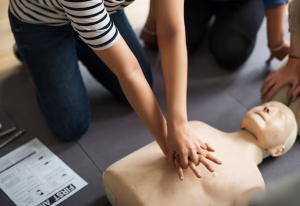In emergency situations, first aid is an essential set of skills that can mean the difference between life and death. Being able to administer emergency treatment is crucial for anything from small wounds to helping someone going into cardiac arrest. Although having a first aid certification is a useful qualification, many people are unsure about how long the certification is valid and how to get certified in CPR and AED. This post will discuss the importance of first aid, how long it takes to become certified in first aid, and offer a comprehensive walkthrough of how to become CPR/AED certified.

The Need for First Aid
The quick and basic care given to someone who is hurt or unexpectedly gets ill is referred to as first aid. Helping someone as soon as possible can help them heal better and keep their injuries or illnesses from getting worse. Here are a few strong arguments for the significance of first aid:
Immediate Care: First aid provides care right away, stabilizing a patient's condition until trained medical assistance can be summoned or lowering the likelihood that minor problems may worsen.
Life-Saving: First aid abilities can be the difference between life and death in emergency situations by preserving circulation and oxygen flow to critical organs. This is especially true when it comes to doing CPR and using an AED.
Injury Prevention: Treating wounds and illnesses as soon as possible with proper first aid helps avert complications and long-term impairments.
Empowerment: Being able to administer first aid gives people the confidence to take charge of situations and help others.
What Is the Duration of First Aid Certification?
Being certified in first aid is a continuous process. Usually, it has a time limit during which it must be renewed. Several factors, such as the certifying organization and the type of certification, might affect how long does first aid certification last. Two years is the typical time for first aid certification.
To guarantee that you have the most recent information and abilities, it is imperative that you renew your certification prior to its expiration. Over time, first aid protocols, methods, and best practices may change. Recertification keeps participants up to date on the most recent policies and recommendations.
Employers, institutions, or organizations may occasionally demand more regular recertification—such as yearly renewals—to ensure that people continue to be competent first aiders.
How to Get Certified in CPR and AED
First aid training includes certification in Automated External Defibrillators (AEDs) and Cardiopulmonary Resuscitation (CPR). When a person has cardiac arrest, an AED is a portable device that helps restore the heart's normal rhythm. CPR is a life-saving procedure that comprises chest compressions and rescue breathing.
Here's a detailed explanation of how to earn your CPR/AED certification:
Choose a Certification Provider: Opt for a reputable organization or certification provider. The American Heart Association (AHA), the American Red Cross, and the American Safety & Health Institute (ASHI) are a few well-known organizations that provide CPR/AED certification.
Select the Right Course: These groups usually provide a variety of CPR and AED classes for different groups of people, including laypeople, childcare workers, and medical professionals. Choose the course that most closely matches your responsibilities and needs.
Enroll in a Course: You can sign up for the chosen course via the organization's website or by getting in touch with a nearby training facility.
Attend the Course: Depending on the alternatives provided by your selected provider, attend the course either in person or virtually. In-person classes usually involve practical exercises to make sure you are proficient in CPR.
Finish the Course and Pass the Exam: Take part in the training, finish the course, and, if necessary, pass the written and practical tests.
Obtain Certification: You will obtain your CPR/AED certification after finishing successfully. This qualification is good for a set amount of time, usually two years.
Renew Your Certification: You must renew your certification prior to its expiration in order to keep it valid and stay up to date with CPR and AED recommendations. Recertification courses are available from many sources; they are usually shorter and concentrate on updating your knowledge and abilities.
Certification in CPR/AED and first aid are important abilities that can make a big difference in emergency scenarios. A first aid certification is usually good for two years, though the exact term may differ. It is imperative that you renew your certification in order to guarantee that you continue to be aware and capable of giving emergency care.
Selecting a reliable CPR/AED certification provider, signing up for the right course, finishing the program successfully, and renewing your certification when necessary are the steps involved in becoming certified. By taking these actions, you can acquire the abilities and information required to offer life-saving support in emergency scenarios and be ready to respond with assurance when crises strike.

























